#the princeton tapes
Text




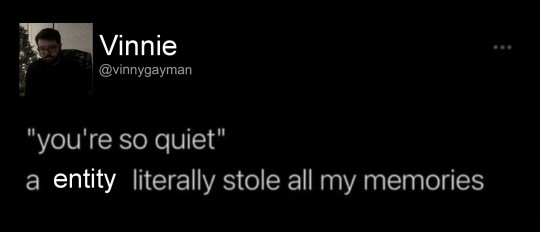
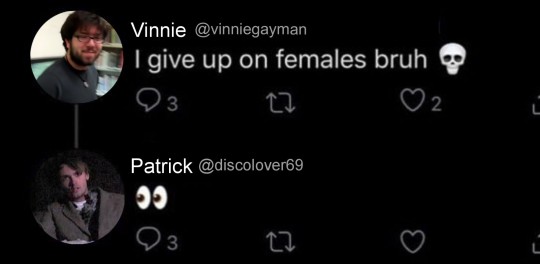

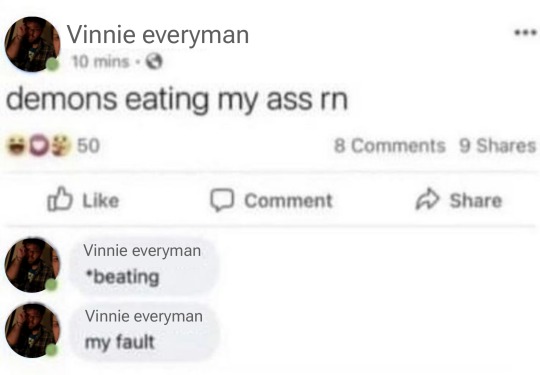

I'm not normal
(the last one is Roger and Vinnie. bc Tim voices him . I can use his pictures leave me alone)
#its .#2 am#almsot 3#so here#hsve.#whatever these sre#🐍 ⦻#everymanhybrid#emh#slenderverse#vinny everyman#vinnie everyman#habit#habit emh#mlandersen0#patrick andersen#firebrand tribetwelve#tribetwelve#roger emh#the princeton tapes#princeton tapes#princeton vinnie#noah maxwell#jeff emh
69 notes
·
View notes
Text
some more EMH moodboards since lots of you guys liked the previous one.
(and happy 14th birthday to the first EMH video!!)
characters for this one are: Alex, Dr. Corenthal, Steph and Roger.
Alex Koval - fawn

Dr. James Corenthal - grizzly bear (like Vinnie, but i put him as an asiatic black bear)

Steph - black cat
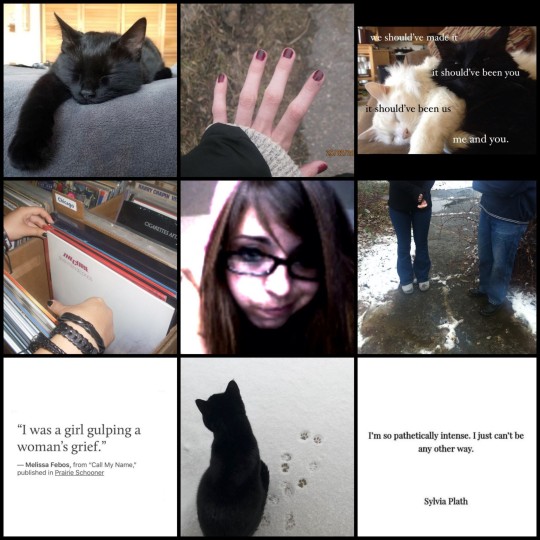
Roger - raccoon (i just used a pic of Tim Sutton for him lol)
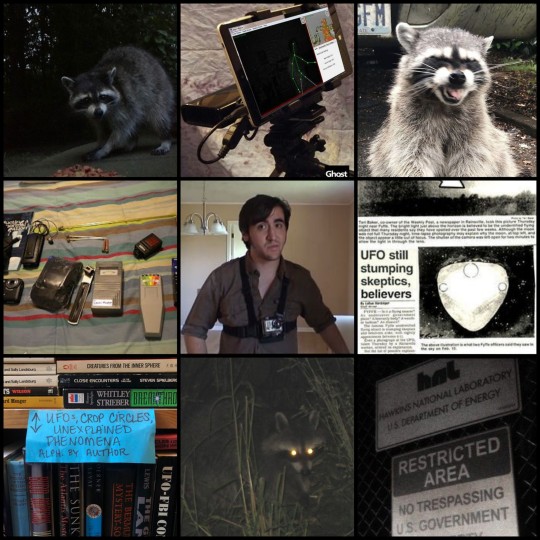
previous one! ˏˋ°•*⁀➷
#slenderverse#poetry#my moodboards#moodboard#moodboards#everymanhybrid#emh#grunge#quotes#2000s aesthetic#alex koval emh#alex koval#steph emh#damsel emh#steph everymanhybrid#james corenthal#dr corenthal emh#fairmount#the princeton tapes#roger emh#roger everymanhybrid
35 notes
·
View notes
Note
you forget a lot don't you?

[A STRANGE LOOK APPEARS ON HIS FACE. BITTER. FAMILIAR. A THOUSAND TIMES HE'S HEARD THIS.]
"uh, yeah,"
[HOLDS BACK A SNORT.]
"i've been in and out of rehab my whole life, and the shit before that... isn't worth remembering."
16 notes
·
View notes
Text
Holy shit bro Princeton Vinnie is so awesome
Hes like
One of the best EverymanHYBRID
I can just
Holds him in hands gently
HHJSHFJDHHFJGJXHFJFFJDHBHDHS
HES SO AWESOME LOOK AT HIM
JUST GOIN THROUGH LIFE WITH A CAMERA
RECORDING THINGS
HAS GROUP THERAPY
BECAUSE HES A FUCKING DRUG ADDICT
But he's nice
Look,
He thinks an iced latte can solve all problems
So that's a plus to the lil guy !!
And he's being stalked by 2 malicious entities ^^
#EverymanHYBRID#The princeton tapes#princeton tapes#slenderverse#Vinnie everyman#vincent cafferello#vincent everyman#princeton vinnie#Vinnie emh#vincent emh#Princeton#The princeton tapes EverymanHYBRID#Princeton EverymanHYBRID#Princeton Vinnie emh
17 notes
·
View notes
Text


stan frederick and princeton tapes patrick and steph
#stan frederick#patrick andersen#steph emh#the princeton tapes#mlandersen0#the record of stan frederick#my art
22 notes
·
View notes
Text
did everyone somehow collectively decide to relisten to the princeton tapes or can tumblr read my mind?
#i had the sudden urge to relisten yesterday and now there’s so much princeton tapes fanart on my feed#slenderverse#everymanhybrid#the princeton tapes
9 notes
·
View notes
Text

#everymanHYBRID#emh#evan myers#evan everymanhybrid#HABIT em#once again shoving slenderverse into my assignments!#the assignment was to make a gif w/ the prompt 'time' and thought OH ITERATIONS?#i wanted to include something w/ princeton tapes ev but couldnt think of a way to like. show that well.#virgil arts#oh yeah i have a higher quality gif elsewhere but it was like 100 mb
454 notes
·
View notes
Text

Happy birthday EMH
#I didn't have a good image of the guys so have this instead#roger paladino#roger emh#everymanhybrid#emh#scribbles#This is specifically 2004 roger but like... it can apply to him in general I think#ty dante for helping with the layout of it btw#princeton tapes
162 notes
·
View notes
Text

he was probably thriving in the 80s. really the decade for weird guys who are into sick shit
20 notes
·
View notes
Text

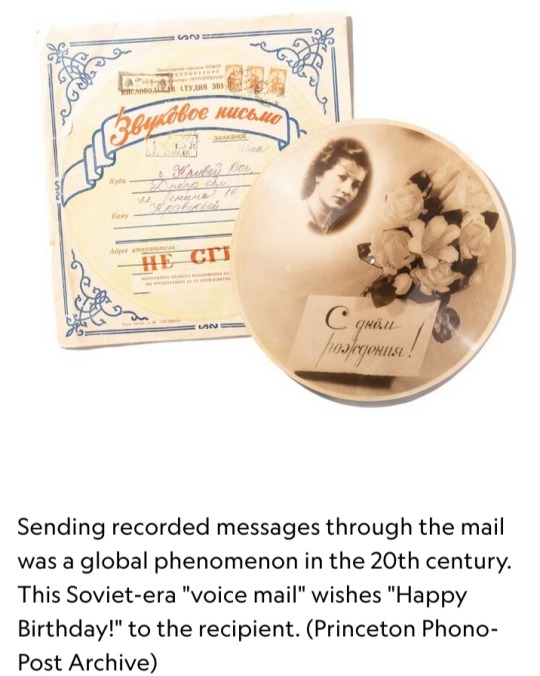
“Hello Mother, Dad, and Blanche,” a quiet voice says above the cracks and pops of an old vinyl record, which has clearly been played many times over.
“How’s everything at home? I’m recording this from Dallas…from this very little place where there are pinball machines and many other things like that…”
The disc is small, seven inches across, dated October 1954.
The faded green label shows that the speaker’s name is “Gene,” the recording addressed to “Folks.”
Gene suggests in his minute-long message that he is traveling — “seeing America” — and tells his family not to worry about him.
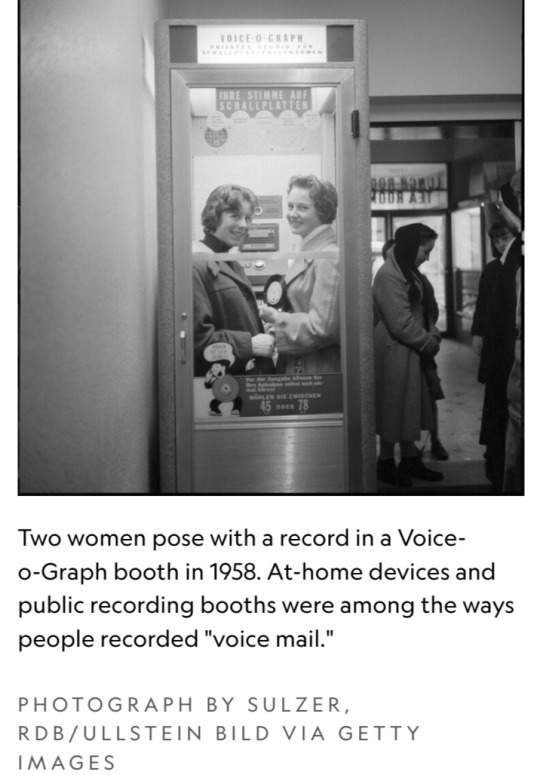
“I should complete my trip sometime around Thanksgiving,” he continues in a second recording made in Hot Springs, Texas, not too long after his first one.
“I hope you received my letter and I, in turn, hope to receive some of the letters that you sent me. It’s been a very long time since we’ve corresponded, and I’m looking forward to hearing from you very, very much.”
This largely forgotten sound is one of the world’s early “voice mails.”
During the first half of the 20th century, these audio letters and other messages were recorded largely in booths, pressed onto metal discs and vinyl records, and mailed in places all over the world.
Best known today for playing music at home, record players were then being used as a means of communication over long distances.
Reach out and touch someone
The idea of transporting a person’s voice had loomed large in the human imagination for some three centuries before it was finally achieved with the invention of the phonograph in the late 19th century.
Historical documents from the Qing Dynasty in 16th-century China suggest the existence of a mysterious device called the “thousand-mile speaker,” a wooden cylinder that could be spoken into and sealed, such that the recipient could still hear the reverberations when opening it back up.

Top: A Kodisk horn and recording stylus attachment in the Princeton Phono-Post Archive was used in the early 1920s for home recordings on pre-grooved blank metal discs using a normal gramophone.
Bottom: A Gem Recordmaker attachment at the Princeton Phono-Post Archive was used in the 1950s for children to "make your own permanent records" on blank six-inch discs using their own gramophone at home.
When Thomas Edison invented the phonograph in 1877, he envisioned a device that could reproduce music and even preserve languages.
He saw, in its earliest uses, the potential to transform business, education, and timekeeping.
He even imagined a so-called “Family Record” — a “registry of sayings, reminiscences, etc., by members of a family in their own voices and of the last words of dying persons.”
But correspondence was at the top of his mind: Edison thought his invention could be used for dictation and letter writing.
In the late 19th century, handwritten letters were the most common form of everyday personal communication.
The telegram, which later became popular in the early 1900s, was used for shorter, urgent messages.
While Alexander Graham Bell made the first transcontinental telephone call from New York to San Francisco in 1915, long-distance calling remained expensive and inaccessible to most ordinary people until the 1950s.
Voice-O-Graph
The gramophone, a later form of the phonograph developed by Emile Berliner in 1887, provided a first possibility for recorded sound being used for long distance communication.
It made recording and playback possible on discs, which were easier to store, reproduce, and send.
The earliest known record to have been put in the mail as a means of correspondence would be sent in the early 1920s, but the practice of sending voice mail really got going across the world in the 1930s and 1940s.
It was personal and affordable as long as customers could find a recording booth or home device.
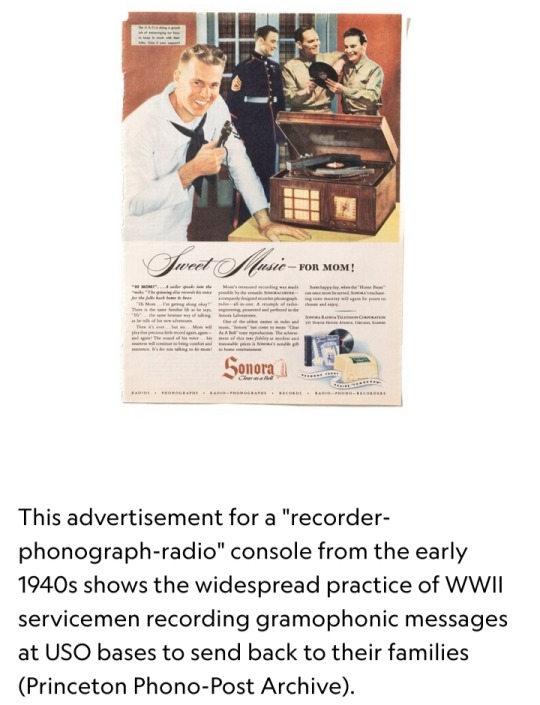
In the early 1940s, the American company Mutoscope rolled out the Voice-O-Graph machine, which vastly popularized voice mail in the United States.
It was a tall wooden cabinet, shaped not unlike a modern-day photo booth, that declared, on one side: RECORD YOUR OWN VOICE!
Invented by Alexander Lissiansky, these recording booths were marketed as novelties and set up at common gathering places: amusement parks, boardwalks, tourist attractions, transportation hubs, military bases and U.S.O. events.
There was a Voice-O-Graph machine at the top of the Empire State Building, on the piers of San Francisco, and by the Mississippi River in New Orleans.
The speaker entered the Voice-O-Graph, inserted a couple of coins, and had a few minutes to record a message.
Then, out popped a record the size of a 45-rpm single that was not only durable enough to be played multiple times, but also flimsy and lightweight enough to send in the mail for little more than the cost of a regular letter.
Oftentimes, the envelopes themselves would come included.
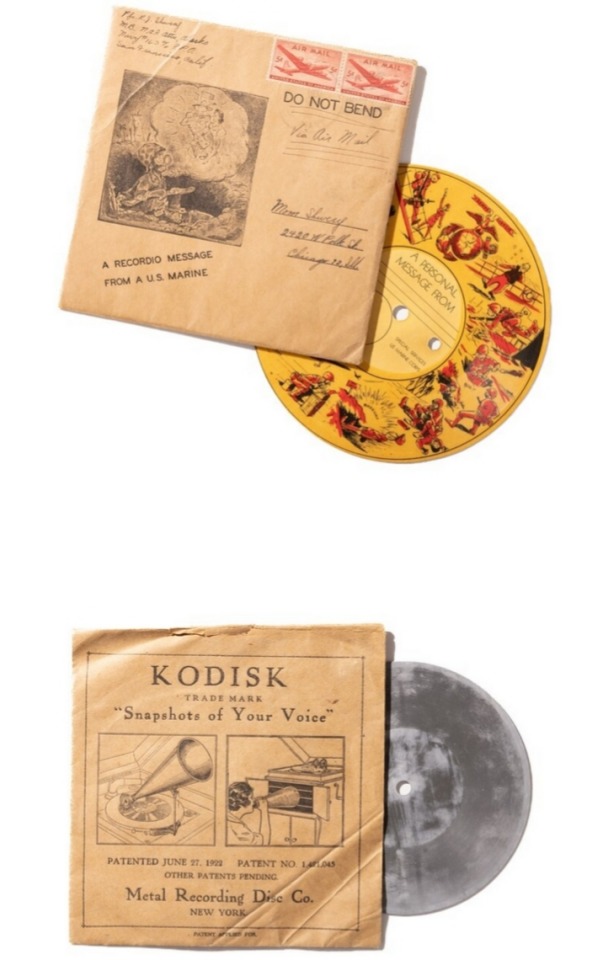
Top: A soldier sends a Christmas greeting to his mother in Chicago.
The envelope, which came with the record, depicts a soldier anxiously imagining his wife with another man in his absence (Princeton Phono-Post Archive).
Bottom: Pre-grooved metal discs were used for domestic gramophone recordings in the early 1920s.
The paper sleeve illustrates the two methods of recording: one, depicted on the right, involved using a megaphone to shout into the phonograph's horn; the other method, depicted on the left, involved using a Kodisk-branded external horn and recording stylus, which would be attached to one's home gramophone and is shown in another image above (Princeton Phono-Post Archive).

Top: A “Recordio” home-recording demonstration disc from the 1940s illustrating five different models of radio-recording-playback consoles made by the Wilcox-Gay Corporation, ranging from massive living-room consoles to portable “airplane type” suitcase versions (Princeton Phono-Post Archive).
Bottom: Wilcox-Gay Recordio demonstration picture disc featuring the violinist and radio star David Rubinoff (1897-1986) and his $100,000 Stradivarius making a recording at home (Princeton Phono-Post Archive).
Photographs by Rebecca Hale, NGM Staff
Words of love
The messages people sent would range in emotion — from excitement to nervousness, joy to embarrassment.
Travelers would make recordings to update family and friends on long trips.
Especially during World War II, where there were recording booths on military bases in nearly every theater of the conflict, soldiers used voice mail to reassure loved ones with the sound of their voice, even if some them would never return home.
There are countless “voice mail valentines,” surprisingly intimate audio love letters.
Many of the messages, sent from far away, express longing.
“You keep your chin up,” a voice named Leland tells his wife in a recording dated 1945, from a booth in New York City.
“All of you keep those chins up. Mike, all of us will all be home, be home where we can pick up, and carry on as we did before.”
In one recording made in Argentina in the 1940s, a man plays the violin before he recites a lullaby.
“Sleep, sleep my darling girl,” the man says. “It’s getting late.”
Phono-Post archive
Back then, families could listen to the messages on repeat — gathering together around the record player whenever one arrived.
They could play it proudly again anytime there were guests, but with each play, the needle would scrape away at the delicate grooves until the message could hardly be heard any longer.

Today at Princeton University, professor and media theorist Thomas Levin is dedicated to preserving these sounds of the past.
He maintains the world’s only archive dedicated to what he calls the “Phono-Post.”
At the height of the phenomenon, there were perhaps thousands of Voice-O-Graph machines in America and many more recording stations across the world.
“Millions of these audio letters were sent across the United States, South America, in Europe, in Russia, in China,” Levin says.
Levin’s office is crammed with many of the items he has collected over the years, including books, posters, and other ephemera—as well as, of course, the records themselves.
Levin has already digitized some 3,000 of the discs, all of which are tucked into clear plastic sleeves and carefully catalogued.
He keeps them filed into cabinets and stackable storage bins in a temperature-controlled room.
Thousands more records lie waiting to be processed in a nearly seven-year backlog that keeps growing as Levin continues collecting.
He employs AI bots that constantly comb through eBay pages and bid for items on his behalf.
Sometimes, he will come across people selling, knowingly or unknowingly, the voice of a relative.
“I write to them and I say, you’re selling the voice of your grandfather?’” Levin says.
“There’s not a sense of the value of the voice, such that people are willing to part with these objects.”
Still, he offers to share an MP3 file of the recording with them, and for that, they are often very grateful.
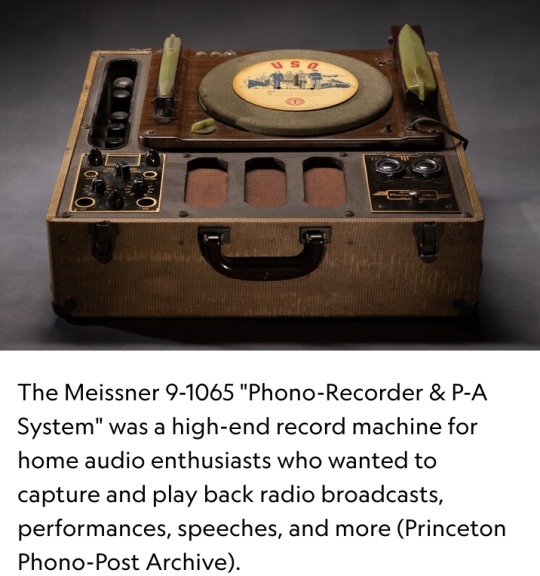
Voices of the Past
For the most part, there aren’t many celebrity voices stashed away in the Princeton Phono-Post Archive.
“The bulk of the recordings in this archive are of very unextraordinary people articulating desires, wishes, fantasies, of a very quotidian sort,” Levin says.
They are enormously telling, if one is willing to listen closely.
Much like paper letters, these audio missives can also reveal insights about particular moments in history through the accounts of individual lives lived within them, but with added layers of sensory detail.
Historical linguists are particularly interested in “voice mail” because it provides some of the earliest-ever recorded samples of how regular people spoke — their conversational vocabulary, their pronunciation and accents, their sentence structure, their intonation.
“There’s no editing. There’s no cleaning up,” Levin says. “Once the recording starts, it will run until it ends, whether you have something to say or not.”
He smiled. “If you don’t have anything to say, that says something too.”
The advent of cassette tapes in the 1960s meant that services like the Voice-O-Graph quickly fell out of fashion.
(For a few decades, people were sending long distance messages on audiocassettes, too — a practice that became particularly common for U.S. soldiers deployed in the Vietnam War.)
But this voice mail phenomenon, while short-lived, holds a significant place in the history of global communication.
“What we’re recovering now are the remnants of a chapter of media history, a cultural practice, that was huge, ubiquitous,” Levin says, “but has now been forgotten.”
For many people, these recordings were the first time they had ever recorded their own voice.
They sound nervous, even awkward, while others even sound like they are reading from a piece of paper.
Some, when faced with their very first self-recording, confronted the realization that they were leaving a highly personal trace that would likely outlive them.
“People strangely, but with remarkable regularity, talk about death,” Levin says.
“They’re writing to a future.” He pauses. “And one thing is known about that future: that they will not be a part of it.”
#voice mails#audio letters#old vinyl record#record players#phonograph#Thomas Edison#telegram#handwritten letters#Alexander Graham Bell#gramophone#Emile Berliner#Mutoscope#Voice-O-Graph#Alexander Lissiansky#Phono-Post#Princeton Phono-Post Archive#Historical linguists#cassette tapes#National Geographic
24 notes
·
View notes
Text
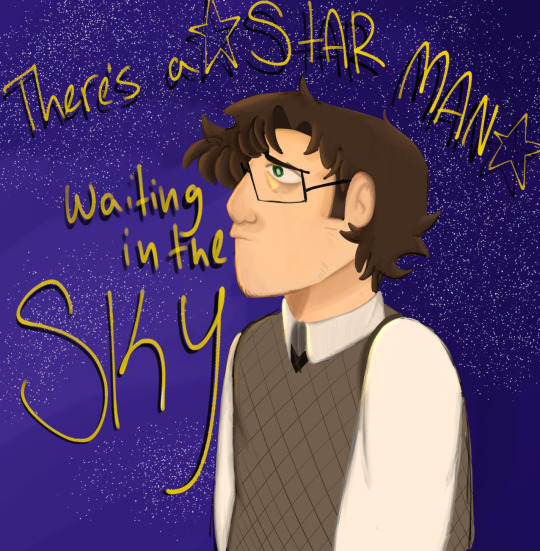
He’d like to come and meet us, but he thinks he’d blow our minds.
20 notes
·
View notes
Note
bpd vinnie is soooo real omg so i was just wondering where it says it in canon? :o

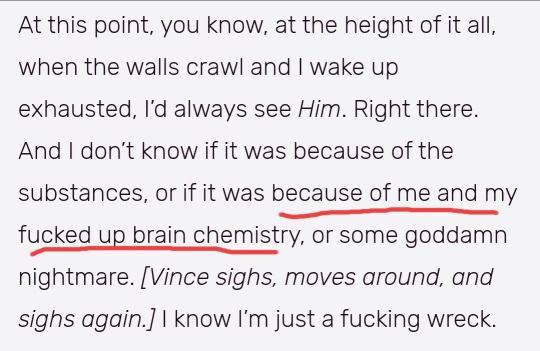


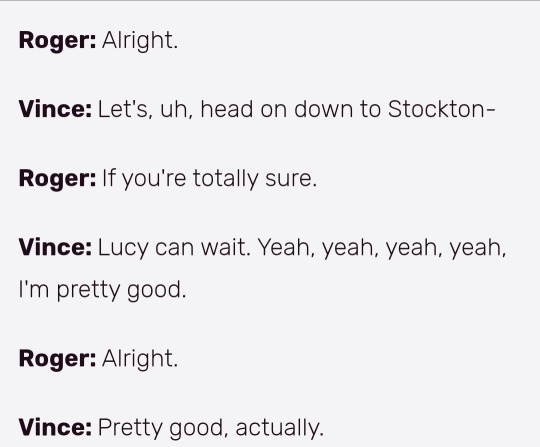

these are from the Princeton tapes!!!
(in order: cold turkey (b), PJs, Morning, Jersey devil pt2, the stockton exchange)
I underlined some of them to point out specific wording too. like his mania!!!! he tends to experience highs and lows and he's constantly shifting around in what emotions he's feeling. During a manic episode, ppl with BPD might experience an extremely elevated or irritable mood. They may also experience having a lot of thoughts all at once and talking super fast.
In some of these I included his interactions w Roger, When Vinnie met Roger he didn't have Jeff or Evan anymore since they disappeared on him, and when Roger appears with answers or as close to answers as he can get Vinnie latches on IMMEDIATELY. He was so desperate for any kind of friend, any kind of interaction and he got it with Roger. You can see that Vinnie is happy when he's with him, and his headspace is clearly in a good place.
But the moment Roger leaves him alone, EVEN IF IT WAS JUST FOR 20 MINUTES, Vinnie could not TAKE IT. it was unexpected, he didn't know where he was, he had never been there before. He felt completely abandoned by Roger and you can see as the tapes go on how this affects how Vinnie treats him and how he thinks about Roger.
I think in this moment Vinnie started to split on Roger.
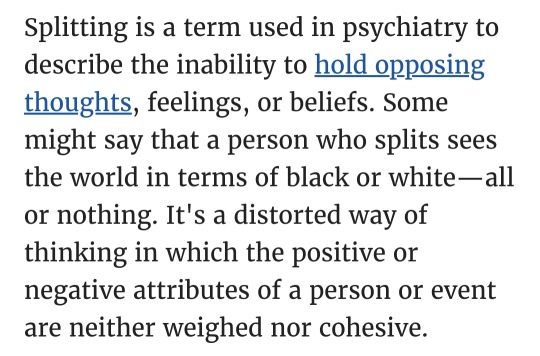


this is from camera obscura
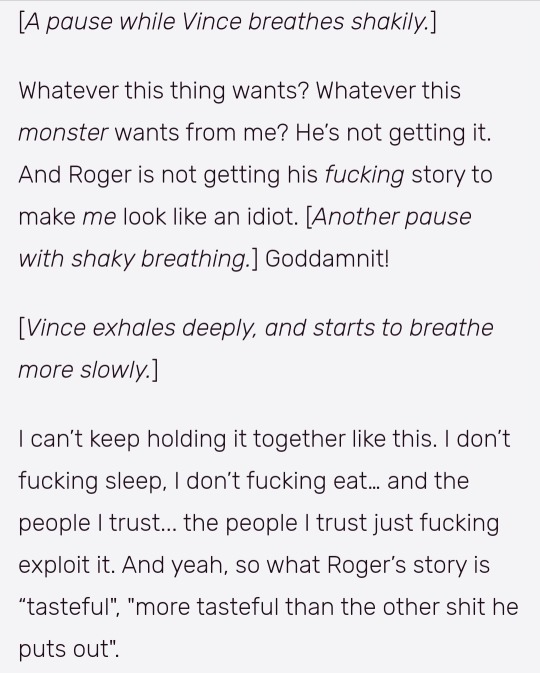
Vinnie is now only convinced that Roger is exploiting him, and that Roger isn't that same guy who he met in the beginning. He can barely even stand talking to Roger at the end of the series, and it was honestly for Rogers benefit. He didn't want Roger to go through what he went through. (sucks that habit got him anyways)
so yyyyyeaahhhhh BPD VINNIE is REAL. AND NO ONE!! CAN TAKE THIS FROM ME
#everymanhybrid#slenderverse#emh#vinnie everyman#vinny everyman#the princeton tapes#🐍 ⦻#ethan rants 🐍
49 notes
·
View notes
Text
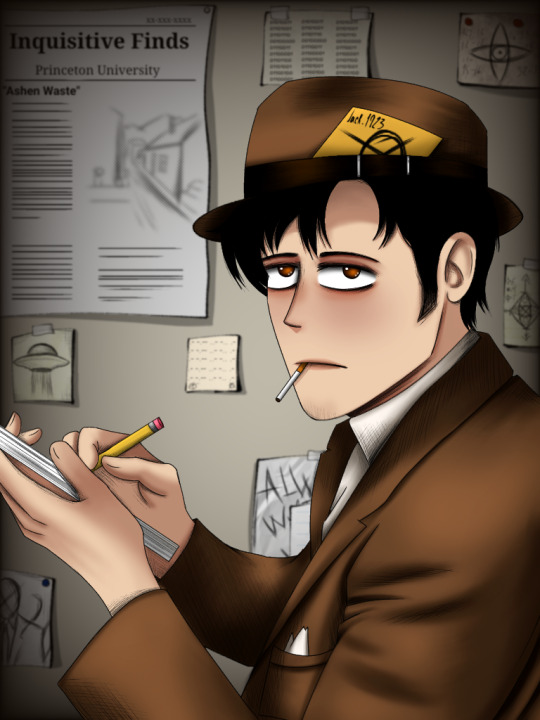
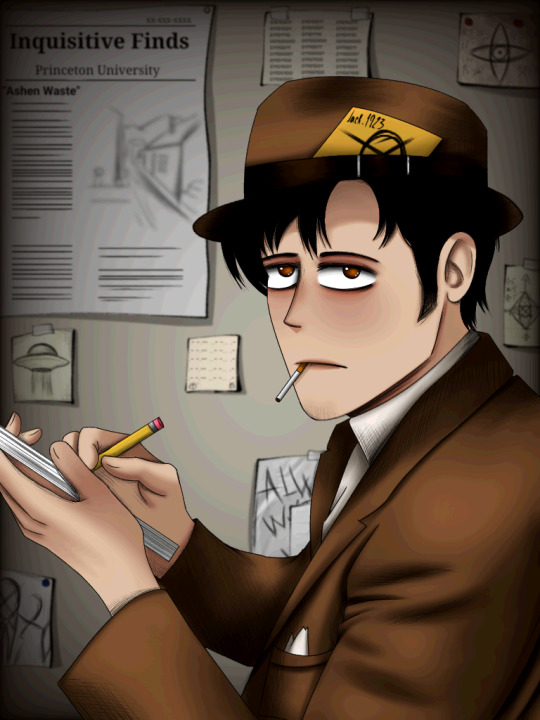
11 notes
·
View notes
Text

" found an old picture in a box, sometime around when i first met evan. this is why you dont let your friends get piss drunk at parties. he fell onto a coffee table, taking me down with him. i still have a scar from where my head hit the corner. "
13 notes
·
View notes
Text
OH MY GOD GUYS HEAR ME OUT ON THIS ONE…. I’VE STARTED WATCHING THE PRINCETON TAPES RECENTLY.
(IM STILL FIGURING OUT THE ITERATION THEORY)
SO I’D LIKE TO THINK ABOUT THE VINNY WE KNOW, PRINCETON VINNY, AND FAIRMOUNT VINNY AS DIFFERENT ITERATIONS.
WE ALREADY KNOW THAT THE DIFFERENT ITERATIONS ARE NOT LIKE EACHOTHER AT ALL, RIGHT? JUST SAME CHARACTERS, SLENDERMAN ENCOUNTERS THEN BAM
BUT WHAT ABOUT THOSE SCENES IN “FINDING FAIRMOUNT” WHERE VINNY SEES DIFFERENT ITERATIONS OF EVAN AND JEFF FIGHTING?? (I HEADCANON THEM AS “CANDLEVERSE” JEFF AND EVAN BTW), WHAT ITERATION ARE THOSE 2 FROM AND WHY DID THEY SUDDENLY APPEAR??
I THINK THAT WAS ITERATION “A” VINNY ENCOUNTERING SOME KIND OF RIP IN REALITY AND SEEING ITERATION B JEFF AND EVAN. THEY COULDN’T SEE HIM.
AAAAAAAAAAAAAAAAAAAAAAA
12 notes
·
View notes
Note
vin and roger chilling?!! playing handhelds?

gotta love the gameboy link cable!!!!!!!
etsy | toyhouse | instagram
13 notes
·
View notes